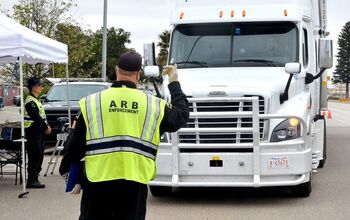Editorial: The California Air Resources Board Says Ni!
Do you ever feel trapped in Monty Python movie? The B&B discussion following Edward Niedermeyer’s post, CARB So Crazy: California To Ban Black Cars, made me think so. First soldier: What? A swallow carrying a coconut? King Arthur: I could grip it by the husk! First soldier: It’s not a question of where he grips it! It’s a simple question of weight ratios! A five ounce bird could not carry a one pound coconut. King Arthur: Well, it doesn’t matter. First soldier: Listen. In order to maintain air-speed velocity, a swallow needs to beat its wings forty-three times every second, right? King Arthur: Please! First soldier: Am I right? I’m no Michael Palin or Graham Chapman, but I’ve got an idea or two about white and black colored cars.
I track mpg with the fortitude of a deranged obsessive-compulsive disordered person checking to make sure the front door of his house is locked. Each time I top off my tank, I record how many miles I’ve driven since my last fill-up. I note whether that tank of gas was expended running about town or on the highway, whether I predominantly used the A/C, and I calculate the fuel efficiency. My ’05 V6 Jeep Liberty has about 58K miles on the odo and I have mileage readings for 54,478 of ’em. I’ve also tracked the mileage of my ’01 4-cylinder Honda Accord over the last 35K miles. Both of my vehicles are metallic black.
The California Air Resources Board proposes to regulate the reflectivity of car paint and windows to increase fuel efficiency. They theorize that lighter colored cars get better gas mileage because the roof reflects more sunlight, so the air conditioner doesn’t have to run as often due to lower interior temperatures. This is great news. Overall, my Jeep gets 16.35 miles per gallon. All I have to do is paint her white and my fuel efficiency will jump . . . how much?
Don’t know. Although CARB’s public presentation contains all sorts of numbers, charts and graphs, they neglect to reference a single study that validates their claim. Come on! All they have to do is get mechanically similar cars painted white or black and compare fuel consumption. Why the rush to take away a woman’s right to choose [the color of her car] (in my family, I chose the hardware and my wife picks the color) when we don’t know whether or not there will be a meaningful savings in CO2 emissions? After all, I thought most Californians were Pro Choice!
Living in north Texas, I am all too familiar with climbing into mobile solar ovens after a long day at work. When it’s really hot outside, everyone has their A/C on. So CARB’s savings claims are based on the fact that four months of each year evening commute temperatures range between 62° F and 77° F—mid-range temperatures where non-reflective cars would need the A/C on after a long soak in the sun but “cool cars” would not.
However, the very Lawrence Berkley National Laboratory (LBNL) study that CARB uses to support their proposal debunks this assumption. The Cooling Load Reduction chart (page 14, “Cool Coatings for Cool Cars: A measure to cool the globe”) shows that by 5 p.m. there is NO difference in air temperature measured at the anterior-heading compartment (i.e., where the driver’s head would be). The “cool car” soaking in the sun heats up slower, but by about 2 p.m., the gap has closed and the interior temperatures remain virtually identical the remainder of the day. Therefore, the only sun soaked vehicles that would see a decrease in A/C usage would be those that leave work at lunchtime, not the masses in evening commute.
When I drive with the A/C on, I get 1.13 (Jeep) and 1.16 (Accord) fewer miles per gallon. There would be no change in A/C usage during the morning since solar soak would not yet be a factor. Additionally, as the LBNL study shows, the proposed “cool car” protections would be of no help during my evening commute. However, over the protestations of my cholesterol clogged arteries, I make a run for fast food about four days a week at lunchtime. Using CARB’s dubious assumption of four months’ savings per year, I could satisfy sixty-nine more Big Mac attacks without switching on my A/C each year. But I don’t travel far—about (generously) six miles round trip.
So what would my annual savings be? 0.68 (Accord) to 1.96 gallons (Jeep).
Ladies and Gentlemen, let the debate carry on.
First soldier: Am I right?
King Arthur: I’m not interested!
Second soldier: It could be carried by an African swallow.
First soldier: Oh yeah, an African swallow, maybe, but not a European swallow. That’s my point.
Second soldier: But then the African swallow’s not migratory . . .
More by William C Montgomery
Latest Car Reviews
Read moreLatest Product Reviews
Read moreRecent Comments
- Theflyersfan OK, I'm going to stretch the words "positive change" to the breaking point here, but there might be some positive change going on with the beaver grille here. This picture was at Car and Driver. You'll notice that the grille now dives into a larger lower air intake instead of really standing out in a sea of plastic. In darker colors like this blue, it somewhat conceals the absolute obscene amount of real estate this unneeded monstrosity of a failed styling attempt takes up. The Euro front plate might be hiding some sins as well. You be the judge.
- Theflyersfan I know given the body style they'll sell dozens, but for those of us who grew up wanting a nice Prelude Si with 4WS but our student budgets said no way, it'd be interesting to see if Honda can persuade GenX-ers to open their wallets for one. Civic Type-R powertrain in a coupe body style? Mild hybrid if they have to? The holy grail will still be if Honda gives the ultimate middle finger towards all things EV and hybrid, hides a few engineers in the basement away from spy cameras and leaks, comes up with a limited run of 9,000 rpm engines and gives us the last gasp of the S2000 once again. A send off to remind us of when once they screamed before everything sounds like a whirring appliance.
- Jeff Nice concept car. One can only dream.
- Funky D The problem is not exclusively the cost of the vehicle. The problem is that there are too few use cases for BEVs that couldn't be done by a plug-in hybrid, with the latter having the ability to do long-range trips without requiring lengthy recharging and being better able to function in really cold climates.In our particular case, a plug-in hybrid would run in all electric mode for the vast majority of the miles we would drive on a regular basis. It would also charge faster and the battery replacement should be less expensive than its BEV counterpart.So the answer for me is a polite, but firm NO.
- 3SpeedAutomatic 2012 Ford Escape V6 FWD at 147k miles:Just went thru a heavy maintenance cycle: full brake job with rotors and drums, replace top & bottom radiator hoses, radiator flush, transmission flush, replace valve cover gaskets (still leaks oil, but not as bad as before), & fan belt. Also, #4 fuel injector locked up. About $4.5k spread over 19 months. Sole means of transportation, so don't mind spending the money for reliability. Was going to replace prior to the above maintenance cycle, but COVID screwed up the market ( $4k markup over sticker including $400 for nitrogen in the tires), so bit the bullet. Now serious about replacing, but waiting for used and/or new car prices to fall a bit more. Have my eye on a particular SUV. Last I checked, had a $2.5k discount with great interest rate (better than my CU) for financing. Will keep on driving Escape as long as A/C works. 🚗🚗🚗


































Comments
Join the conversation
MikeInCanada, I agree. I suspect the interior color is more important than the exterior color. It is the dark interior that absorbs the rays coming though the glass instead of reflecting them. I doubt the outside color of the engine compartment or the trunk have much relevance. The top and the doors might matter, but the interior not being able to reflect out much solar radiation has got to matter when in comes to air conditioning. By the way, I hate black interiors. IMO the default colors for interiors should be light tan or light gray with the exception of the top half of the dash which should be mat black.